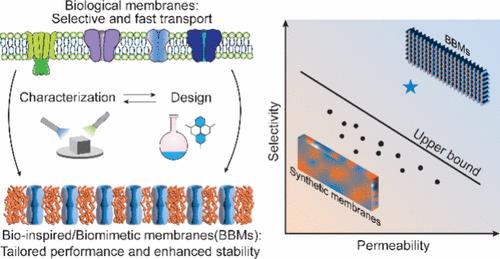Approaching Ideal Selectivity with Bioinspired and Biomimetic Membranes
IF 15.8
1区 材料科学
Q1 CHEMISTRY, MULTIDISCIPLINARY
引用次数: 0
Abstract
The applications of polymeric membranes have grown rapidly compared to traditional separation technologies due to their energy efficiency and smaller footprint. However, their potential is not fully realized due, in part, to their heterogeneity, which results in a “permeability–selectivity” trade-off for most membrane applications. Inspired by the intricate architecture and excellent homogeneity of biological membranes, bioinspired and biomimetic membranes (BBMs) aim to emulate biological membranes for practical applications. This Review highlights the potential of BBMs to overcome the limitations of polymeric membranes by utilizing the “division of labor” between well-defined permeable pores and impermeable matrix molecules seen in biological membranes. We explore the exceptional performance of membranes in biological organisms, focusing on their two major components: membrane proteins (biological channels) and lipid matrix molecules. We then discuss how these natural materials can be replaced with artificial mimics for enhanced properties and how macro-scale BBMs are developed. We highlight key demonstrations in the field of BBMs that draw upon the factors responsible for transport through biological membranes. Additionally, current state-of-the-art methods for fabrication of BBMs are reviewed with potential challenges and prospects for future applications. Finally, we provide considerations for future research that could enable BBMs to progress toward scale-up and enhanced applicability.

接近理想选择性的生物启发和仿生膜
与传统的分离技术相比,聚合物膜由于其节能和占地面积小而应用迅速发展。然而,它们的潜力并没有完全实现,部分原因是它们的非均质性,这导致了大多数膜应用的“渗透性-选择性”权衡。受生物膜复杂的结构和优异的均匀性的启发,仿生膜(BBMs)旨在模拟生物膜的实际应用。这篇综述强调了bbm的潜力,通过利用生物膜中定义明确的可渗透孔和不渗透基质分子之间的“分工”来克服聚合物膜的局限性。我们探索了生物有机体中膜的卓越性能,重点关注它们的两个主要成分:膜蛋白(生物通道)和脂质基质分子。然后,我们讨论了如何用人工模拟物取代这些天然材料以增强性能,以及如何开发宏观尺度的bbm。我们强调在脑卒中领域的关键演示,利用负责通过生物膜运输的因素。此外,目前最先进的制造方法,对潜在的挑战和未来的应用前景进行了回顾。最后,我们提出了对未来研究的考虑,这些研究可以使bbm朝着规模扩大和增强适用性的方向发展。
本文章由计算机程序翻译,如有差异,请以英文原文为准。
求助全文
约1分钟内获得全文
求助全文
来源期刊

ACS Nano
工程技术-材料科学:综合
CiteScore
26.00
自引率
4.10%
发文量
1627
审稿时长
1.7 months
期刊介绍:
ACS Nano, published monthly, serves as an international forum for comprehensive articles on nanoscience and nanotechnology research at the intersections of chemistry, biology, materials science, physics, and engineering. The journal fosters communication among scientists in these communities, facilitating collaboration, new research opportunities, and advancements through discoveries. ACS Nano covers synthesis, assembly, characterization, theory, and simulation of nanostructures, nanobiotechnology, nanofabrication, methods and tools for nanoscience and nanotechnology, and self- and directed-assembly. Alongside original research articles, it offers thorough reviews, perspectives on cutting-edge research, and discussions envisioning the future of nanoscience and nanotechnology.
 求助内容:
求助内容: 应助结果提醒方式:
应助结果提醒方式:


